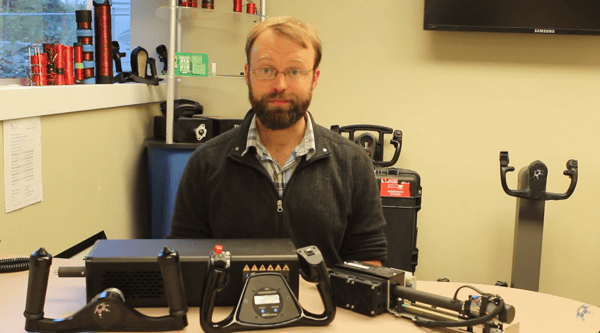Iris Dynamics designs and manufactures smart magnetic linear actuators for OEM applications. Our force-controlled actuators are fully integrated and provide software-defined, backdrivable force control (also known as force feedback or control loading). The ORCA Series Smart Linear Motors deliver low-latency, easy-to-deploy force control for robotics, manufacturing, laboratory automation, and autonomous vehicle systems.
ORCA actuators are used in both research and deployed environments, including flight simulation, aerospace testing, and control-surface actuation, as well as across robotics, industrial automation, and remote field operations. Their magnetic direct-drive design provides smooth, repeatable performance in varied conditions, from controlled laboratory tests to working platforms in the air, on land, and at sea.
Although we no longer build consumer flight controls, the same technology that powered our early yokes, pedals, and joysticks now drives high-speed motion control and force-controlled actuator systems used globally by engineers, researchers, and commercial developers advancing next-generation motion technologies.

From Force Feedback Yokes to Linear Motion Technology
Early control loading (force feedback) systems typically simulated control forces using rotary or linear actuators connected through belts, gears, or ball screws. These systems relied on load cells and external feedback loops to approximate aerodynamic feel. Motor torque passed through mechanical linkages before reaching the control column, often introducing friction, backlash, and latency.
Each subsystem, including the motors, motor drivers, controllers, sensor interfaces, and power electronics, was usually housed in separate enclosures and connected through long cables to a remote control cabinet. Every connection added communication delay and potential noise pickup. Traditional designs also depended on feedback-only control, where the system reacted to sensed error after it occurred. This approach could reproduce general control loads but lacked the responsiveness needed for high-frequency force or motion cues.
Iris Dynamics’ early magnetic direct-drive yokes replaced all that hardware with a single integrated linear motor. The actuator created force directly along the motion axis using precisely controlled magnetic fields. Because the sensing, drive, and logic electronics were built onto the same circuit board, command and measurement occurred within microseconds. The much shorter signal paths eliminated cable latency and synchronization errors common in distributed systems.
This architecture enabled feed-forward control in addition to feedback. Instead of waiting to sense an error, the actuator anticipates commanded changes and applies force in real time. The internal control loops operate on sub-millisecond timescales, much faster than the human tactile and proprioceptive response of roughly 20 to 50 milliseconds. As a result, users perceive a continuous physical connection rather than a delayed correction.
Other systems often produce faint harmonics or vibration caused by belt resonance or motor cogging. The magnetic direct-drive design eliminates these effects, delivering silent, stable motion with no perceptible mechanical hum.
The result was a brushless linear motor with inherent mechanical compliance, smooth motion, and no mechanical wear. Those same principles now form the basis of the ORCA Series Smart Linear Actuators, extending this technology from simulation hardware into industrial, robotic, and aerospace applications.

Pedals, Joysticks, and the Path to ORCA
Iris Dynamics commercially produced force feedback yokes beginning with a Kickstarter campaign in 2012.These yokes were eventually sold under the product name DragonflyVR and were the first to use direct-drive magnetic linear motors to deliver realistic control loading without belts, gears, or ball screws. The company also developed rudder pedals and several joystick prototypes using the same actuator principles.
These systems demonstrated that linear magnetic technology could scale across multiple control axes while maintaining accurate, software-defined force output.
The yokes were sold commercially for several years and helped validate both the mechanical and control design that became the foundation for later integrated actuator systems. In 2017,
Iris Dynamics shifted focus toward creating turnkey actuator solutions that allowed customers to integrate the same core motor technology into their own applications. This work eventually led to the introduction of the DCA Series and BAB Series of fully integrated linear motors, which represented early generations of what would become the ORCA Series.
In 2022, the ORCA Series Smart Linear Actuators were formally launched, incorporating the latest generation of drive electronics, embedded sensing, and magnetic design improvements. Each ORCA actuator combines the performance of a fast linear actuator and electric cylinder actuator with the precision and responsiveness of a direct-drive linear motor.
Unlike belt-driven or ball screw systems, ORCA actuators are entirely magnetic, eliminating friction and backlash. They use brushless linear motor technology with integrated force, position, and temperature sensing to form compact, force-controlled motion systems capable of software-defined compliance and high-speed control.
Control Architecture
How It Works
To deliver realistic force feedback and control loading, an actuator must respond faster than the human proprioceptive system. Each Iris Dynamics actuator generates force through precisely controlled magnetic fields acting on a magnetic shaft. By continuously measuring and regulating these fields in real time, the actuator produces controllable, backdrivable forces with sub-millisecond latency. Because there are no gears, belts, or ball screws, motion is smooth, quiet, and free of mechanical friction or backlash.
All internal control loops and PID functions operate within the actuator itself. Force, velocity, and position are measured and regulated directly inside the unit, allowing responses on sub-millisecond timescales. In most applications, the external system defines the desired force or behavior, and the actuator determines how to achieve it locally. This approach simplifies system integration while maintaining high precision and stability.
The result is an actuator that feels continuous, stable, and precise in systems ranging from simulation to fielded motion control platforms.
Understanding Force Control and Mechanical Compliance
A force-controlled actuator regulates output force directly rather than relying only on position control. This enables This capability makes it possible to vary stiffness, damping, and compliance entirely through software. The actuator can behave as rigid or as compliant as required, functioning as a software-defined mechanical element instead of a fixed component.Because sensing and computation occur on the same electronics board, there are no long cable runs or communication delays. Internal control bandwidth is significantly higher than human tactile perception, allowing the actuator to reproduce physical interactions with continuous, natural response and no perceptible lag.
Each actuator behaves like a software-defined spring, providing stable, repeatable force output even in dynamic or impact-driven environments. This design supports advanced control strategies in simulation, robotics, aerospace testing, and automated equipment.
